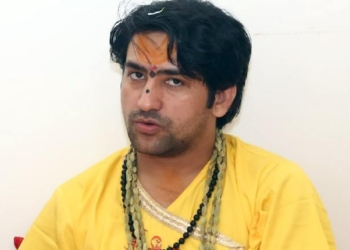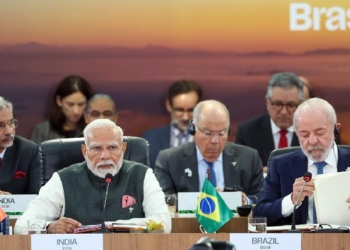New Delhi: Human trafficking remains a distressing global epidemic that knows no boundaries. It affects millions of lives, with devastating consequences for victims, especially women and children. On the occasion of the World Day Against Trafficking, the United Nations Office on Drugs and Crime calls for collective action to leave no victim behind.
With the recent release of the Global Slavery Index 2023, it becomes evident that certain G20 nations, including India, are grappling with significant trafficking challenges. India, with its large population and diverse socio-economic landscape, faces a pressing need to combat this menace.
The Magnitude of Human Trafficking:
According to the Global Slavery Index 2023, six G20 nations, including India, account for more than half of the world’s modern slavery victims.
India alone has 11 million victims, comprising men, women, and children trapped in this vicious cycle.
The report highlights the alarming prevalence of modern slavery in various countries, emphasising the urgency of addressing this issue collectively.
The report also mentions about 10 countries with the highest prevalence of modern slavery are North Korea, Eritrea, Mauritania, Saudi Arabia, Turkey, Tajikistan, United Arab Emirates, Russia, Afghanistan, and Kuwait.
Human trafficking, a billion-dollar industry, affects hundreds of thousands of individuals annually and ranks as the third-largest international criminal enterprise, generating an estimated $150 billion annually (ILO, 2014).
Governments worldwide invest millions in combating this issue.
India, with its large population and complex social dynamics, has become a hotspot for various forms of trafficking.
According to NCRB data, 2,189 trafficking cases were filed in 2022, involving 6,533 victims. Among them, 4,062 were female, 2,471 were male, and 2,877 were minors. While more underage boys (1,570) were trafficked in 2021, adult victims saw women outnumbering men.
Certain states, like Telangana, Maharashtra, and Assam, reported higher trafficking cases, making them vulnerable to cross-border trafficking facilitated by neighbouring countries.
The Complexity and Reach of Trafficking:
Trafficking transcends borders and affects individuals from all walks of life. Traffickers often prey on vulnerable individuals seeking a better life or living in unstable conditions. Deceived by false promises, victims find themselves trapped in deplorable working conditions, exploited for little or no pay.
Human trafficking remains an affront to the dignity and wellbeing of around 27.6 million victims worldwide (71 per cent are women and girls, and 29 per cent are men and boys).
Accurate data on trafficking victims is challenging to determine due to under identification and hidden nature of the crime.
The Impact on the health of Victims:
The consequences of human trafficking are far-reaching and devastating, inflicting significant harm and substantial health implications on individuals and communities. Trafficking victims endure a myriad of health issues, including:
Sexually Transmitted Diseases (STDs) and HIV/AIDS: Victims forced into the sex industry are at high risk of contracting STDs and HIV/AIDS due to unprotected sexual encounters.
Pelvic Pain, Rectal Trauma, and Urinary Difficulties: Working in the sex industry subjects victims to physical abuse and trauma, resulting in pelvic pain, rectal injuries, and urinary complications.
Pregnancy from Rape or Prostitution: Female victims often experience unwanted pregnancies as a result of rape or coerced prostitution.
Infertility from Untreated STDs or Unsafe Abortions: Chronic untreated sexually transmitted infections or unsafe abortions can lead to infertility among female victims.
Infections and Mutilations from Unsanitary Medical Procedures: Traffickers may subject victims to unsanitary and dangerous medical procedures, leading to infections and mutilations.
Chronic Back, Hearing, Cardiovascular, or Respiratory Problems: Endless toiling in hazardous conditions like agriculture, sweatshops, or construction can cause chronic health issues.
Weak Eyes and Eye Problems: Working in dimly lit sweatshops can lead to weak eyesight and other eye-related problems.
Malnourishment and Serious Dental Problems: Child trafficking victims often suffer from malnourishment and severe dental issues, leading to retarded growth and poorly formed teeth.
Infectious Diseases like Tuberculosis and Hepatitis: Overcrowded and unsanitary living conditions in trafficking situations can increase the risk of infectious diseases.
Undetected or Untreated Diseases such as Diabetes or Cancer: Lack of access to proper healthcare and medical attention may leave victims with undetected or untreated chronic conditions.
Bruises, Scars, and Physical Abuse: Victims of the sex industry may bear bruises and scars from physical abuse and torture, with attackers often avoiding visible areas to conceal their actions.
Substance Abuse and Addiction: Some victims turn to substance abuse as a coping mechanism or are coerced into drug use by their traffickers.
Psychological Trauma: Daily mental abuse and torture inflict profound psychological trauma, leading to depression, stress-related disorders, disorientation, confusion, phobias, and panic attacks.
Feelings of Helplessness, Shame, Humiliation, Shock, Denial, or Disbelief: The constant exploitation leaves victims with overwhelming emotions, including feelings of helplessness,shame, humiliation, shock, denial, or disbelief.
Cultural Shock: Many victims find themselves in unfamiliar countries, facing cultural shock and alienation, further exacerbating their distress.
Addressing human trafficking’s health implications requires collective efforts to combat this heinous crime and provide comprehensive support and rehabilitation for victims, empowering them to reclaim their dignity and lead fulfilling lives.
India’s efforts to combat trafficking have been bolstered by the introduction of the Draft Trafficking in Persons Bill, 2021.
Once enacted, the bill will broaden the definition of victims, covering all citizens and foreign nationals residing in India, including transgenders. It aims to hold offenders accountable, including government officials and those in positions of authority.
Penalties and Protections:
The bill proposes stringent penalties, with life imprisonment for trafficking multiple children and the seizure of properties acquired through trafficking income. Additionally, the National Investigation Agency (NIA) will lead the fight against trafficking, while the National Anti-Human Trafficking Committee will oversee the law’s implementation.
Financial Assistance and Strengthening Units:
The Ministry of Women and Child Development recently approved a scheme to provide financial assistance to establish protection and rehabilitation homes in states and Union Territories, especially in regions with international borders.
This initiative aims to cater to the specific needs of victims, offering them essential support and care.
To reinforce the fight against trafficking, the government has allocated funds from the Nirbhaya Fund to strengthen anti-human trafficking units (AHTUs) across all states and Union Territories. These units play a crucial role in detecting and combating trafficking activities.
Conclusion:
India’s Battle Against Trafficking: Human trafficking remains a pressing global challenge, impacting millions of lives worldwide.
India, as one of the countries significantly affected, is taking a robust approach to combat this menace.
The Draft Trafficking in Persons Bill, 2021, and the recent initiatives to provide financial assistance and strengthen anti-human trafficking units demonstrate the nation’s commitment to safeguarding the dignity and rights of trafficking victims.
To truly make a difference, it is essential to work collectively on a global scale to eradicate this heinous crime and ensure a brighter future for victims everywhere.
(IANS)













